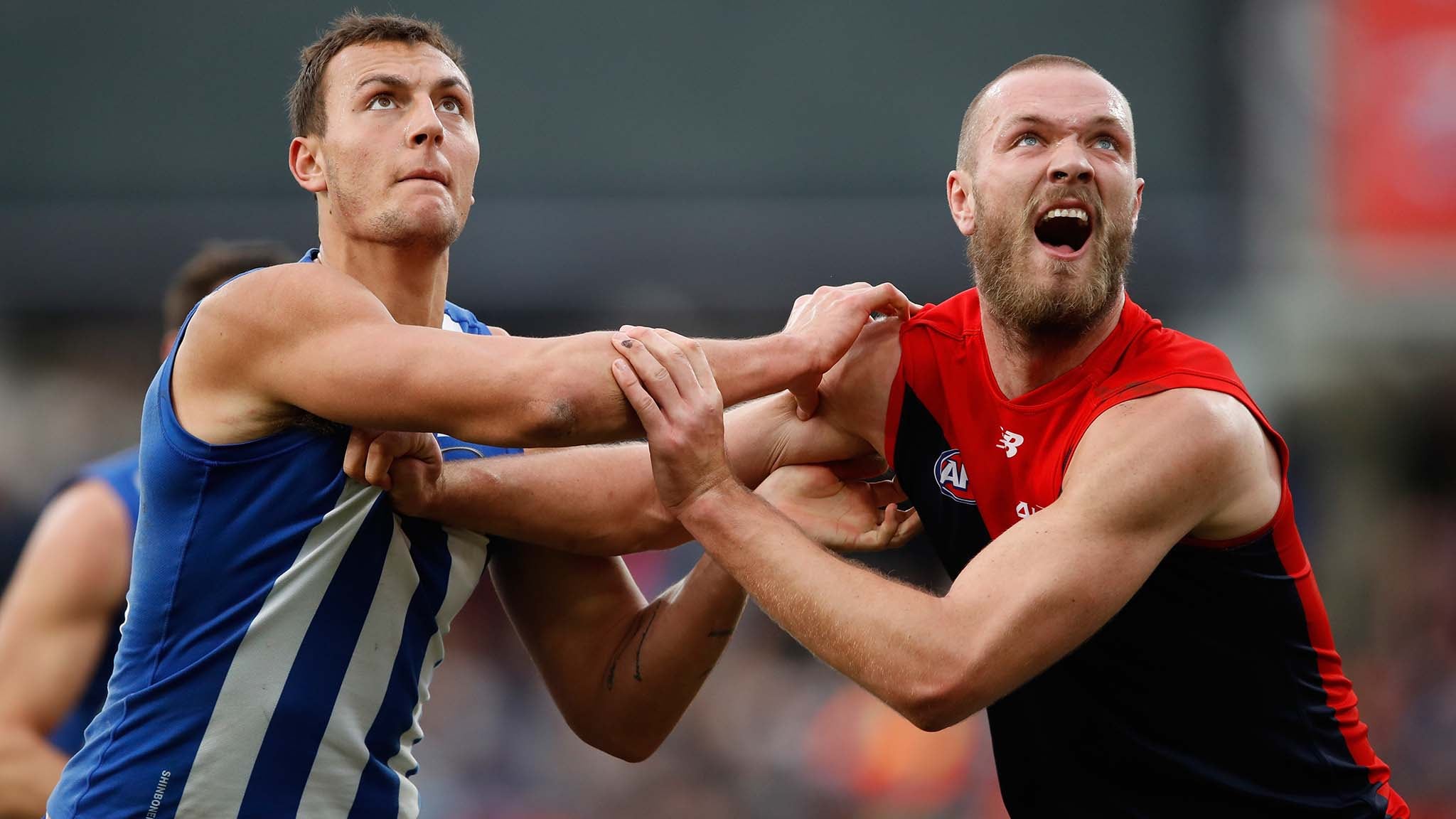Ruck contests: prior opportunity
A ruckman who takes direct possession of the ball from a bounce, throw-up or boundary throw-in will no longer be regarded as having had prior opportunity.
THE AFL'S best tacticians are wildly split at this early stage on what the new ruck rule will mean for the knights of the centre circle next year.
Ruckmen are now free to grab the ball out of any ruck contest with the benefit of the same prior opportunity as every other game situation across the ground.
The rule tweak was one of nine announced on Thursday after a forensic investigation into the game's trends in the past decade and wide-ranging opinions were sought.
The second specialist ruckman largely went the way of the dinosaurs during the AFL's five-year flirtation with the substitute rule between 2011 and 2015.
Instead, Shaun Grigg – all 190cm of him – represented the new wave of undersized back-ups that limited the damage in ruck contests before transforming into an extra midfielder at ground level.
Most clubs never went back, although West Coast's Grand Final triumph was underpinned by a two-pronged ruck set-up all season with any combination of Nic Naitanui, Scott Lycett and Nathan Vardy.
That group of big men is blessed with great athleticism and the ability to play in attack, assets not every club boasts with its ruck supplies.
DEFENSIVE WEAPON BLUNTED David Rath on the new rules
But the AFL's copycat nature, combined with the ruck changes, means some clubs are already planning to experiment this summer with how they can fit two ruckmen in the same side.
Tactics for the upcoming season are typically fleshed out between November and February, so there is still plenty of time to figure it out.
Braydon Preuss' arrival at Melbourne raised eyebrows across the competition, given he appears to have moved into a worse personal situation behind Max Gawn compared to the older Todd Goldstein.
But were the Demons ahead of the curve?
Were they simply addressing their porous depth behind Gawn, or did they sell Preuss on a dynamic new ruck strategy that will see him become a senior regular?
That remains to be seen, but we can hypothesise on how it might work after watching Gawn morph into an intercepting force down back in Jake Lever's knee-related absence from round 12.
He averaged one intercept mark in the first 11 rounds with Lever, but that spiked to 2.4 without him as he spent more time cutting off opposition forays to protect Melbourne's backline.
Could a continuation of that, even with Lever returning, present a situation where Gawn rucks in the defensive half and Preuss operates in the front half as more of an offensive weapon?
Preuss and Gawn will be in the same colours in 2019 ... and potentially in the same team. Picture: AFL Photos
Richmond's premiership success last year with Grigg spelling Toby Nankervis is why many people swiftly labelled the ruck rule change as the Tigers' Kryptonite.
But Grigg may still be a viable ruck option, according to one club's game analyst.
"There's nothing in the rules that made me think you would (play two ruckmen), unless you were like West Coast and playing two forward-ruck athletic types," the analyst told AFL.com.au.
"Being able to take the ball out of the ruck doesn't hurt the Grigg type – you just tackle them straight away.
"The (new) centre bounce rule is the one that might make teams think about it, because you can't run a forward or two off the back (of the centre square) to give you coverage."
That's where things get even more interesting and intriguing.
The centre square rule being referred to will see teams having to station six players in the two 50m arcs at the start of quarters and after goals, including one in each of the goalsquares.
Who clubs place in the goalsquare in that scenario is sure to launch plenty of debate.
Is it your No.1 key forward? A fast-leading type who is good overhead, like Dustin Martin? Or could the No.2 ruckman play that role?
"I think everyone will discuss it," the analyst said.
"One of the risks for clubs like the Tigers, who went small with their second ruck, or the Dees, if they want to play two giants, is that you risk the things that make you a good team."
Who could the clubs pair?
Adelaide: Sam Jacobs, Josh Jenkins
Brisbane: Stefan Martin, Oscar McInerney
Carlton: Matthew Kreuzer, Andrew Phillips
Collingwood: Brodie Grundy, Mason Cox
Essendon: Tom Bellchambers, Sam Draper
Fremantle: Aaron Sandilands, Rory Lobb*
Geelong: Rhys Stanley, Ryan Abbott
Gold Coast: Jarrod Witts, Peter Wright
Greater Western Sydney: Dawson Simpson, Matthew Flynn
Hawthorn: Ben McEvoy, Jon Ceglar
Melbourne: Max Gawn, Braydon Preuss
North Melbourne: Todd Goldstein, Majak Daw
Port Adelaide: Paddy Ryder, Scott Lycett
Richmond: Toby Nankervis, Ivan Soldo
St Kilda: Billy Longer, Rowan Marshall
Sydney: Sam Naismith, Callum Sinclair
West Coast: Nathan Vardy, Tom Hickey**
Western Bulldogs: Tim English, Tom Boyd
* Rory Lobb's trade to Fremantle was anticipated
** While Nic Naitanui is out


